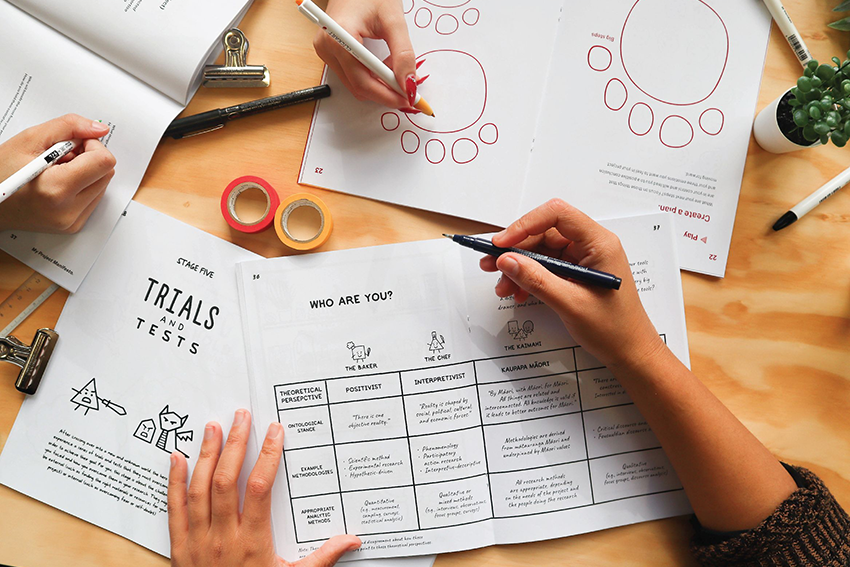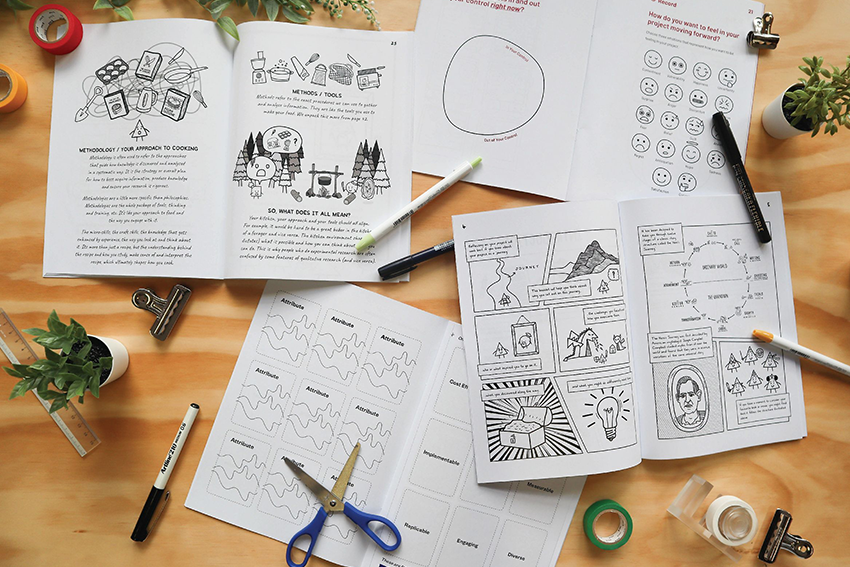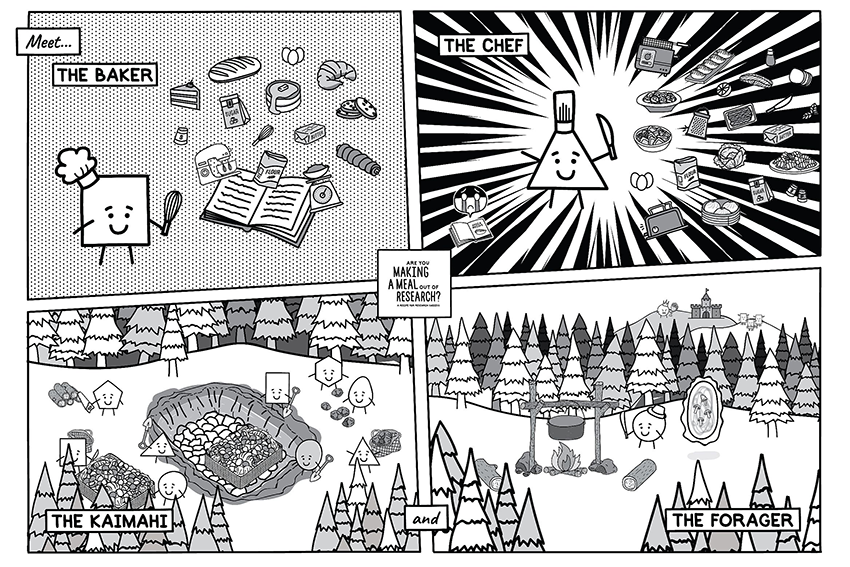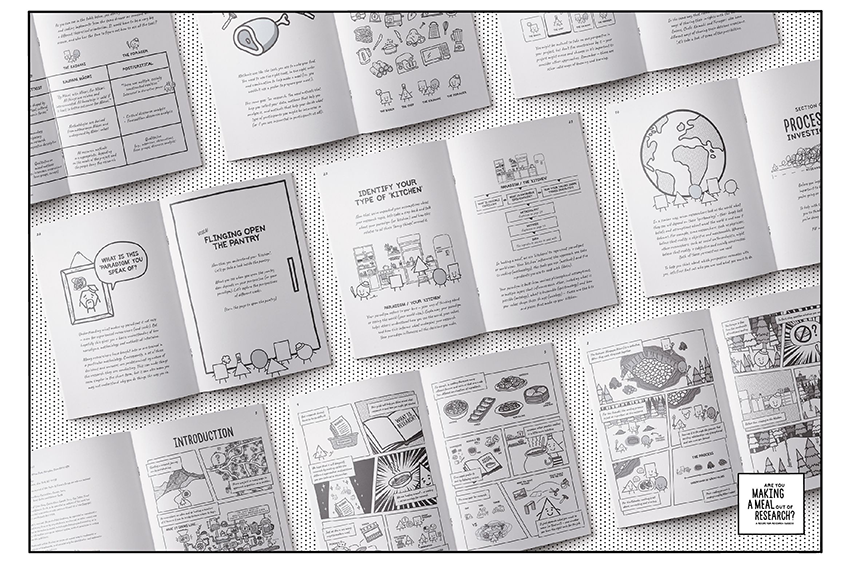Are you making a meal out of research?

Are you making a meal out of research? That’s the question a new workbook created by the Good Health Design team at AUT hopes to help answer.
According to the academics behind the book, those new to research can find it daunting and often don’t know where to start.
The answer isn’t to hand them a thick textbook about epistemology, paradigms and methodology, says School of Art & Design Professor Stephen Reay, one of the co-creators.
“New researchers often don’t understand those kinds of big scary words and, to be fair, I’m not sure all academics do either,” Professor Reay laughs.
“We've designed quite a few resources that use more visual and creative methods to tell simple stories – and that’s continued with this latest workbook. It’s designed to get people started and help them position their research before they get into the dense and hardcore texts.”
Are You Making a Meal Out of Research? A Recipe for Research Success is effectively the fourth in a series of books around the postgraduate student journey to come out of Good Health Design, and developed in collaboration with a range of people across AUT. It uses similar techniques and style to previous workbooks My Project Manifesto, Little Red and My Hero’s Journey.
That includes expert drawings from Research Officer Cassie Khoo, who illustrates the cooking metaphor used throughout the latest offering in her own distinctive style.
She tapped into her own student experience to take what Professor Reay and the other creators - Senior Lecturer Dr Gareth Terry from School of Clinical Sciences, Dr Valance Smith from the Office of the Vice-Chancellor, Trent Dallas and Dr Guy Collier – had scripted.
“I'm probably closest to a student in terms of understanding and age,” Khoo says.
“So I approached it as if I was trying to communicate it to someone like me, who maybe doesn't have that research experience.
“I thought the visual comic was a really engaging way of presenting otherwise complex ideas and would be something that I would find more appealing as a student trying to make sense of it all.”
Dr Terry was “excited” to be part of the collaboration, saying he was well aware of Good Health Design’s previous work, and he found it “clever, thoughtful and engaging”.
“I teach across a broad range of possible methodological approaches, so I started coming into conversations around how to formulate some of the language and to give a sense of connection to the textbooks,” he says.
“I started to recognise that what we were doing was producing something which translated the long-winded philosophical textbooks into something quite digestible and engaging.”
One of the keys for the co-creators was filling a gap, particularly with students learning in a variety of different ways. That leads to Professor Reay saying he hasn’t seen anything else like it.
"Students can grab it and read through it in five or 10 minutes and get a sense of the overarching questions or thinking that they need to engage in,” he says.
“And obviously it goes deeper than that, because you can then spend an hour or two working through various questions and then hours putting together building a methodology for their research.”
“It provides a framework that I don't know that existed prior to this,” he concludes.
Another key aspect was the involvement of Dr Valance Smith and Trent Dallas, who brought their knowledge of kaupapa Māori to the table.
Dr Smith says that providing any resource to help students on their research journey should be encouraged.
“I saw this book as an opportunity to do that in a creative and visually stimulating way that might better connect to students who respond to this medium,” he says.
“Featuring kaupapa Māori in the book was important to both support our Māori students on their research journey, and also to elucidate kaupapa Māori research to non-Māori by providing insights on how to engage appropriately with Māori researchers using kaupapa Māori as their research paradigm.”
The work also highlights the fact that there are several ways of producing knowledge that are equally beneficial to humanity, says Dr Terry.
“It recognises there is value that can be offered from each of these different ways of looking at the world.”
Using multiple world views makes the workbook more flexible, as it doesn’t favour a single approach, so it’s useful for more than the post-graduate students it’s mainly aimed at.
“That includes stage two physiotherapy students who are now going to be picking up this book and using it to navigate through the research literature,” Dr Terry says.
It can also be used by other academics to introduce students to a topic which can be difficult to understand, while allowing students to find their own path to understanding.
“It highlights the possibilities available, and it doesn’t leave you thinking you have all the answers yet,” says Professor Reay.
“One of the key components of the last pages of the book is pointing in the direction of stuff that you should be reading to expand on the workbook.
“This is just sort of getting your head in the game.”
Students and staff who want to find out more can pick up the book at the AUT shop while both physical and electronic copies can be bought via publisher Routledge’s website.


